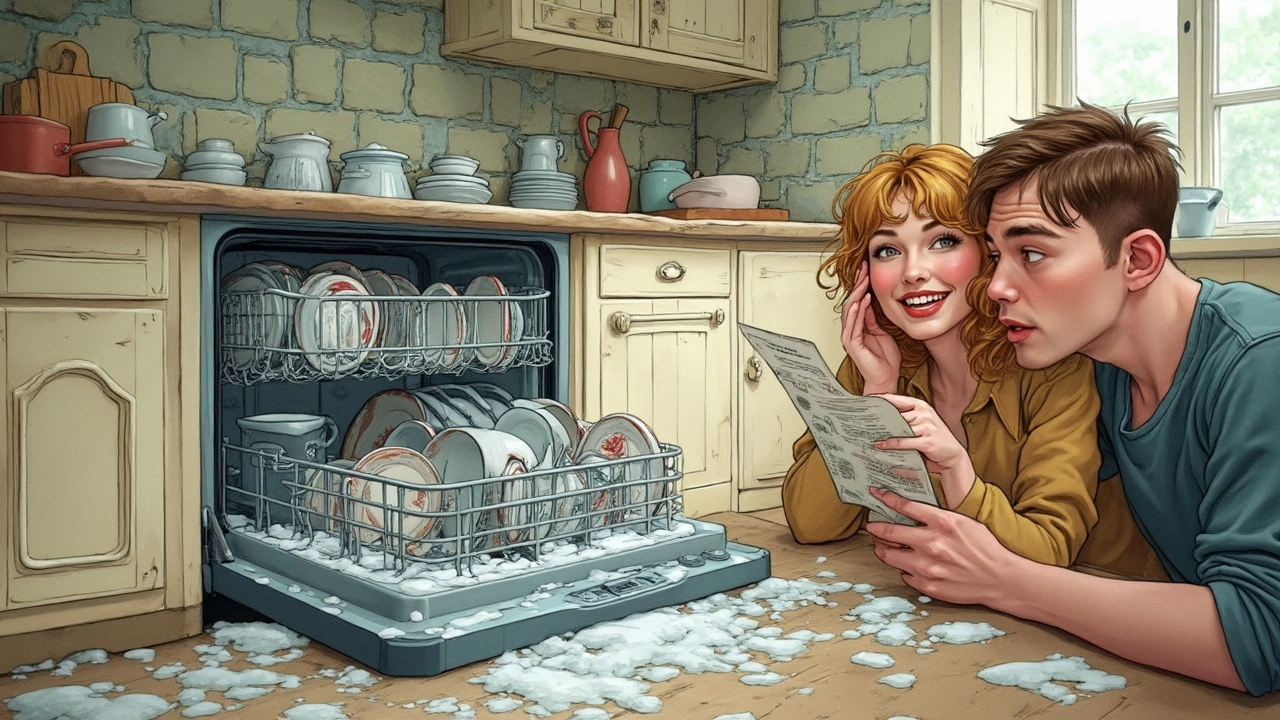When your dishwasher decides to take a day off, it usually starts with the water not heating up. This is often due to a faulty heating element or a broken thermostat. Before you panic, check for any burnt-out wires or scale build-up on the element itself. Don't forget that a reset might just be all it needs; flipping the breaker can sometimes work wonders.
Ever unloaded the dishwasher only to find your plates still grimy? Chances are, the culprit is clogged spray arms. These deliver water throughout the machine, and even the smallest debris can cause chaos. Regularly clean those holes with a paperclip, and while you're at it, keep the filters free of food scraps.
Another common headache is when water puddles at the bottom. It could be a draining issue, often due to a blocked drain hose. Give it a good inspection and clear any gunk stuck inside. If you're lucky, it might just be a simple kink in the hose that's easy to straighten out.
Finally, that door that won't shut right? A faulty latch or damaged door seal could be to blame. Inspect the latch for signs of wear or misalignment. Sometimes, a warped or torn gasket is the issue. Replacing these parts usually solves the problem and prevents annoying leaks.
Water Not Heating
So, your dishwasher isn't heating water. This isn't just a minor annoyance—it's a showstopper. Dishes won't get cleaned properly without hot water. Let's get to the bottom of this issue.
Check the Heating Element
The first suspect is typically the heating element. This little piece does the heavy lifting by warming up the water. Start by disconnecting power and water supply. Look for any visible damage, like breaks or corrosion. You can test the element's continuity with a multimeter. No continuity? It's time for a replacement.
"A faulty heating element is a common issue, but it's easily fixable with the right tools and some patience," says appliance repair expert Sarah Simmons.
Thermostat Troubles
If the heating element looks fine, your thermostat might be on the fritz. The thermostat controls the temperature, and if it’s off, so is your cleaning process. Again, a multimeter is your friend here. A broken thermostat means the heat won't kick in when it should.
Control Board Problems
When both the heating element and thermostat check out, the control board could be malfunctioning. Modern dishwashers have a control board similar to a computer. Check for any burn marks or corrosion on the board. If the board's faulty, consider calling in a professional. Messing with it yourself might void warranties or cause more damage.
These steps should point you in the right direction. Remember, regular maintenance can prevent most of these headaches, keeping your dishwasher running smoothly for years.
| Component | Common Issues | Solution |
|---|---|---|
| Heating Element | No continuity, visible damage | Replace |
| Thermostat | Malfunction, incorrect reading | Replace |
| Control Board | Burn marks, corrosion | Professional repair |
Dishes Not Coming Out Clean
If you've opened your dishwasher only to discover grimy plates and glasses, you're not alone. This is a common issue many face with their trusty kitchen companion. Let's break down the possible reasons and what you can do about it.
Check the Basics
First things first, ensure that you're not overloading the dishwasher. It might sound trivial, but cramming too much inside can block the spray arms from spinning freely, meaning water doesn’t reach all your dishes. Make sure your dishes are arranged properly with enough space so water can circulate efficiently.
Examine the Spray Arms
Speaking of spray arms, these little guys are crucial for getting dishes spotless. If debris blocks the holes, the water pressure will drop significantly. Take time to clear these holes with a toothpick or a thin wire. Regular checks can save you from a common dishwasher repair problem.
Use the Right Detergent
It’s not just about how much detergent you use, but also about the type. Using too much soap can lead to residue build-up, while using too little might not give the needed strength to clean stubborn grime. Refer to your dishwasher's manual for recommended amounts and consider high-quality detergents specifically marked for automatic dishwashers.
"A little maintenance goes a long way in extending the life of your dishwasher. Regular cleaning, proper loading, and the right detergent are key to sparkling clean dishes." — Jane Smith, Appliance Maintenance Expert
Look at the Filters
The filters are your dishwasher's last line of defense to trap food particles. Over time, these filters can become clogged, which restricts water flow. Clean the filters weekly by rinsing them under hot water and scrubbing gently with a brush. Don’t let these go neglected, as they're your primary block against food debris recycling through your dishwasher.
Check Water Temperature
Lastly, ensure that the water entering your dishwasher is hot enough. Ideally, it should be around 120°F (49°C). If it's too low, residue might not dissolve properly, leaving your dishes less than pristine. A quick fix is to run the kitchen sink until the water is hot before starting your machine – easy but effective.

Dishwasher Not Draining
Finding a puddle of water at the bottom of your dishwasher can be frustrating. There are several reasons why a dishwasher might not be draining properly, but tackling the problem is usually straightforward. Let's dive into what causes this and how you can fix it.
Clogged Drain Hose
The drain hose is essentially the pathway for dirty water to exit your dishwasher. A kinked or clogged hose is a common issue that prevents water from draining. Here’s how you can check it:
- First, make sure the dishwasher is turned off and unplugged for safety.
- Locate the drain hose, which is usually connected to the garbage disposal or air gap at one end and the dishwasher at the other.
- If there are any kinks, carefully straighten them out.
- To clean the hose, detach it and use a long, flexible brush to remove any blockages.
Blocked Filter
The filter traps food particles, ensuring they don't circulate back onto your dishes. If not cleared regularly, it can block water flow. Here’s a simple way to clean it:
- Remove the bottom dish rack and locate the filter at the base.
- Twist it counterclockwise to remove it.
- Rinse the filter under running water to remove residues.
- Place it back securely before running another cycle.
Garbage Disposal Connection
If you've recently installed a new garbage disposal, the knockout plug might still be intact. Here's how to check:
- Disconnect the drain hose from the garbage disposal.
- Look inside the hose connection on the disposal. If you see a plastic piece blocking it, that’s the knockout plug.
- Use a hammer and screwdriver to gently knock it out.
Pump or Motor Malfunction
Sometimes, the issue is deeper within, such as a broken pump. If the basic checks don't resolve the issue, it could be time to call in a professional to examine these components.
Stats and Maintenance Tips
Regular maintenance is vital for avoiding drainage issues. In general, aim to clean the filter weekly and inspect hoses monthly to save on costly repairs.
Doors and Latch Issues
A wonky dishwasher door can feel like a drama you don't need in the kitchen. Surprisingly, dishwasher issues often start here. If the door won't shut properly, your first check should be the latch. Over time, latches can loosen up or get misaligned, making your dishwasher think the door is open when it's not.
Inspecting and Adjusting the Latch
Start with a visual inspection. Look for wear or any debris lodged in the locking mechanism. Clean it up with a damp cloth. If cleaning doesn't help, try adjusting the latch position:
- Loosen the screws on the latch plate with a screwdriver.
- Move the latch plate slightly left or right to align it better with the locking mechanism on the door.
- Retighten the screws, and test the door to see if it catches right.
This small adjustment can sometimes be all it takes to make your dishwasher think twice about alarming you.
Replacing a Faulty Latch
If tweaking doesn't resolve the latch issues, you might need a new latch. Here's how to replace it:
- Unplug your dishwasher for safety.
- Open the door and unscrew the inner door panel to access the latch.
- Disconnect the wires from the latch assembly, making note of their positions for reassembly.
- Remove the old latch and swap in a new one.
- Reconnect the wires, screw the panel back on, and plug the dishwasher in for a test run.
Replacing a latch isn't rocket science, but if you're not comfortable, consulting a professional is a solid alternative.
Dealing with Door Seals
While checking dishwasher repairs, don't overlook the door seal. A damaged or worn-out gasket can cause leaks, and that's a mess nobody wants. Inspect the rubber lining around your dishwasher's door:
- If it looks warped or cracked, it's time for a new one. These seals are typically easy to pull out and replace.
- Press the new gasket into place, ensuring a snug fit all around to keep water safely inside.
Minor fixes can extend the life of your dishwasher and keep your kitchen floor dry, not to mention avoiding a slip-and-slide scenario.

